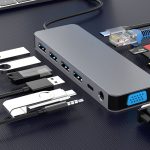When you notice your skin is not as firm as it used to be, it can be a bit concerning. And then you start to google, “How to deal with saggy skin,” and you’ll most likely get a lot of interesting search results for invasive and expensive procedures, or miracle tools or creams that promise to firm your skin right up for the low, low price of $19.99. It’s a rabbit hole, for sure.
To help sort it all out, I went to the experts to get their thoughts on skin-tightening treatments. Of course, if you’re considering a treatment, you’ll want to have a discussion with your own dermatologist so that they can help figure out a plan that works for your specific concerns and skin type. It’s also important to note that certain skin changes are just part of getting older. “As a natural part of the aging process, we all lose collagen and elastin,” says Joyce Imahiyerobo-Ip, MD, FAAD, owner of Vibrant Dermatology and SkinBar MD. “These two proteins are essential to maintaining our skin’s firmness. The result of a loss of collagen and elastin increases skin laxity and sagging skin.”

But generally, skin-tightening treatments can run the gamut. “When I think of skin tightening, I think of radiofrequency, microneedling, ultrasound or laser resurfacing procedures that all stimulate collagen to some degree to decrease fine lines, wrinkles, crinkles, and surface texture,” says Corey L. Hartman, MD, FAAD, founder of Skin Wellness Dermatology. “Most of these treatments involve some sort of heat-based energy or, in the case of micro-needling, a mechanical stimulation of fibroblasts through micro-needles. Laser skin tightening is the act of improving the texture, tone, and tautness of the skin through laser and heat energy. It is one of the most high-impact procedures to erase sun damage, tighten skin, and prevent skin laxity.”
But in some cases, these in-office treatments might not work. “I wouldn’t recommend these interventions for those with severe skin laxity or extremely sun-damaged skin, or those who are expecting results akin to a face-lift because they are less likely to have a significant or satisfying improvement,” says Samantha Ellis, MD, a clinical instructor of dermatology at the University of California, Davis.

Well, it turns out most people can get these procedures, and it doesn’t really matter what skin type they have. That’s because Ellis says generally the treatments target tissues below the uppermost layers of the skin. “Everyone is a good candidate for either preventative or corrective treatments that can help to improve their skin,” Hartman says. “Those with darker skin tones should be careful about pursuing certain resurfacing lasers, but there are many safe options as well to help this population of patients that can be delivered effectively as long as they are done by experienced hands.”
And while they’re generally safe and there are a few serious side effects associated with these in-office treatments, Imahiyerobo-Ip says individuals who are pregnant, nursing, or have certain medical conditions might not be candidates. She recommends discussing your medical history with your healthcare provider before going forward with a treatment.

Wondering what the procedures entail? The experts broke down some of the most common in-office skin-tightening treatments for us below:
CO2 Laser Skin Resurfacing: “Carbon dioxide lasers very precisely remove thin layers of skin with minimal heat damage to the surrounding structures,” Hartman says. “Carbon dioxide lasers treat wrinkles, photodamage, scars, warts, keloids, and more. The chromophore is water, and therefore, patients should hydrate in preparation for the treatment.” A CO2 laser is an ablative laser, which works by traumatizing the skin. Hartman explains that it removes the thin outer layer of skin (epidermis) and heats the underlying skin (dermis). It stimulates the growth of new collagen fiber, and as the epidermis heals and regrows, skin looks clearer, smoother, and tighter. This stimulates the growth of new collagen fibers. As the epidermis heals and regrows, the treated skin appears clearer, smoother, and tighter.
Ultrasound Therapy: “Certain skin-tightening treatments use focused ultrasound to heat the skin and stimulate collagen,” Imahiyerobo-Ip says. “Ultrasound therapy has been used in medicine for several decades and has an excellent safety profile. Ultherapy is a widely used, FDA-approved focused ultrasound device. Treatments take about one hour. There is no downtime. However, individuals may experience significant discomfort. It may take up to two to three months to see results.”
Micro-Needling: Also called collagen induction therapy, micro-needling is minimally invasive and stimulates collagen production. “A mechanical pen—its head filled with tiny needles—is rolled over the skin, and as it vibrates, it delivers microinjections, penetrating the skin many times over the course of a few seconds,” Hartman says. “The needles are used to create a controlled skin injury or multiple minor injuries, which will then allow the skin to heal and produce a newly rejuvenated complexion.”

Radio Frequency: A newer technology, radio frequency uses an increase in temperature to tighten and smooth skin and trigger collagen production. “The goal is to induce thermal damage to stimulate collagen production in deep layers of the skin and subcutaneous tissue,” Hartman says. “There are many different radio frequency devices on the market, and their effects and downtime vary widely across the spectrum.”
Imahiyerobo-Ip adds that these treatments can also be delivered with micro-needling. “When combined with micro-needling, these treatments can also improve collagen and elastin in the deeper layers of the skin,” she says.
Fraxel Laser Resurfacing: “Fraxel uses microscopic columns of laser energy to treat only a fraction of the tissue at a time, leaving the surrounding area intact,” Hartman says. “This allows swift healing and triggers the natural healing processes of the body to replace damaged or old cells with new, healthy, fresh, glowing skin.” It’s effective for wrinkles and fine lines, acne scars, sun damage, excessive pigmentation, sunspots, actinic keratosis, and more. Hartman also adds that it can safely treat men and women of any age and skin color.
Erbium Laser Resurfacing: This is a milder and less invasive treatment option than the CO2 laser. Since the CO2 laser removes deeper layers of damaged skin, the erbium treatment is good for people whose damage is not as severe. “It precisely ablates the epidermis (the outermost layer of the skin) to reveal the underlying skin that is smoother and younger-looking,” Hartman says. “The procedure also activates collagen to promote further tightening of the skin. An erbium laser skin resurfacing treatment is performed as an outpatient procedure with the use of a local or topical anesthetic.”

If you’re considering trying an at-home product or device that is said to tighten or firm skin, you’ll want to be very careful when you shop. All the derms I spoke to said that you aren’t going to be able to get the same results as you would with an in-office treatment. That being said, there are a couple of ingredients and devices that could help.
“One of the most potent ingredients for tightening the skin from the outside in is retinol,” Imahiyerobo-Ip says. “Retinol and prescription retinoids tighten the skin by stimulating collagen and elastin production. Other ingredients that have been shown to improve skin laxity include peptides and growth factors. When you apply exogenous peptides onto the skin, it tricks the skin into thinking there has been an injury, which in turn stimulates collagen production.” Ellis adds glycolic acid is another ingredient that can boost collagen production.

As for at-home devices, Hartman warns that they don’t achieve the level of heat, depth of penetration, or level of ablative controlled injury that the in-office procedures do. “Most of these devices deliver microcurrents of electricity to stimulate muscles or collagen but pale in comparison to the results of professional treatments,” he says.
If you do want to buy a device, Ellis says product reviews can be helpful or speak to someone who has used the device before. That’s because there is not that much data to support their efficacy, and it’s hard to know if it’s going to really work for you. “It also has to fit into your schedule, so it’s important to pay attention to how often and for how long the device needs to be used to see results,” Ellis adds.
And read the directions carefully before using them. Imahiyerobo-Ip says she has had patients come to her office with first-degree burns due to improper use of home devices.
If you do want to shop some products, see below for some recommendations. Again, it’s important to keep in mind that you’re not going to get the same results as a professional in-office treatment, but they might be worth a try if you’re still considering those types of treatments.

Imahiyerobo-Ip likes the NuFace (above) and NuBody (below) devices for their skin tightening benefits. “These devices are painless and work by stimulating muscle tone and blood circulation to the face and by increasing product penetration,” she says. “They both utilize microcurrent technology to improve muscle tone. When the underlying facial musculature is tightened, the skin appears smoother.”

This one is paired with the brand’s Hydrating Aqua Gel Activator to help it glide better on the skin while also reducing the appearance of fine lines and wrinkles and brightening the skin.

For those who are new to retinoids, Imahiyerobo-Ip recommends this drugstore find. It’s formulated with vitamin B3, which helps to even skin tone, smooth skin texture, and reduce the appearance of fine lines and wrinkles.

TNS Essential Serum is one of Imahiyerobo-Ip’s favorite growth factor/peptide combinations. There are two active formulas in this product that are even dispensed out of separate chambers and are then combined when you smooth them on your skin.

This crowd-favorite drugstore moisturizer is infused with vitamin B3, amino-peptides, hyaluronic acid, and antioxidants to firm, improve elasticity, target fine lines, and hydrate. The formula gets 10 layers deep into the skin to boost its moisture levels.

First Aid Beauty’s rich night cream targets dryness and a loss of firmness and elasticity. Ingredients include colloidal oatmeal to calm dry skin, sodium hyaluronate to boost moisture, and niacinamide to restore a visible bounce to the skin.

With 14,000 ratings and 4.5 out of 5 stars on Amazon, Palmer’s firming body lotion is worth a try. And it’s low-stakes, too, since it’s $6. It’s specially formulated to target skin that isn’t as firm anymore due to pregnancy or weight loss.

This face serum works to boost collagen and tighten the skin. It’s infused with bamboo, coconut oil, coconut water, a natural retinol alternative complex, a plant stem cell concentrate, and monoi—all. of which work to restore the skin’s moisture barrier, tone, smooth, and firm.

Use this retinol-powered lotion all over your skin to keep it hydrated, soft, and firmer. It also targets uneven tone.

If you’re seeing changes in the eye area, try this firming retinol eye cream that also brightens and hydrates the skin around the eye. It has a gold applicator tip that will feel cool and refreshing when you use it.
Next, Are Lasers as Magical as Everyone Says? I Asked a Derm My Burning Questions
Powered by WPeMatico






